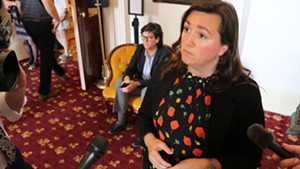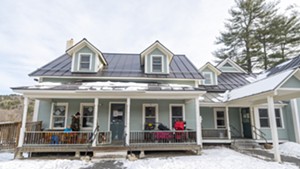
- File: Jeb Wallace Brodeur
- A preschool class at Turtle Island Children's Center in Montpelier
Released on Tuesday, the lengthy report offers a range of tax-based options for raising that revenue. Top state lawmakers have said a comprehensive childcare bill is a top priority this legislative session. Gov. Phil Scott has been less vocal about the issue and has expressed resistance to raising taxes. He's scheduled to give his annual budget address on Friday.
Lawmakers commissioned the study, completed by the RAND Corporation, as part of Act 45. Passed in 2021, the measure outlined a number of goals for early childhood education in the state, such as ensuring that families spend no more than 10 percent of their annual income on tuition and early childhood educators are paid fairly.
Related Report: Major Changes Needed for 'Broken' Early Childhood Ed System

Report: Major Changes Needed for 'Broken' Early Childhood Ed System
Education
Researchers found that the total annual cost for a high-quality early childhood education system with a well-compensated workforce would run around $645 million per year. Already existing public-sector funding, plus families that pay tuition, would cover a large chunk of the cost, leaving a gap of somewhere between $179 million and $279 million per year for the state to cover. The range accounts for different levels at which families would contribute to childcare costs; the RAND study examined five.
In all the scenarios considered, the state would continue to fully pay childcare tuition for families with an income at or below 150 percent of the poverty level — which translates to a household income of $42,000 for a family of four. In other scenarios, the state would provide subsidies for families with higher household incomes — up to around $139,000 — so that they would pay no more than 10 percent of their income on childcare.
The study also factored higher salaries for early childhood workers into its analysis — from a starting salary of around $35,000 for assistant teachers to $59,000 for lead teachers with bachelor's degrees — and benefits such as health insurance, paid time off, retirement, and short- and long-term disability.
Currently, the median annual salary for assistant teachers working in early childhood education is around $22,000; for teachers, it is less than $40,000, according to a 2021 report.
Related Vermont's Childcare System Isn't Working for Providers or Parents. They Hope Help Is on the Way.

Vermont's Childcare System Isn't Working for Providers or Parents. They Hope Help Is on the Way.
News
One is a 0.9 percent payroll tax, which researchers characterized as "progressive" because it would result in higher-income households bearing a disproportionate amount of the cost.
Another possibility would be a 2-percent increase in sales tax, which was deemed "regressive" because lower income households would bear a disproportionate share. The study cautioned that "any sales tax increase over about 1 percent would push Vermont, currently at 6 percent, to one of the highest sales taxes in the country."
Other "single-source" options included a new service tax — ranging between 7.1 and 9.9 percent — on a variety of personal and entertainment services, including dry cleaning, newspapers subscriptions, cable TV and fitness center memberships.
"It is difficult to say whether taxes on services are regressive, progressive, or neutral," the study states, "since those with higher incomes are more likely to consume more services than lower income but may spend a smaller proportion of their income."
The study also suggested "bundles" of taxes, such as a smaller increase in the payroll or sales tax, combined with a 15 percent tax on soft drinks and a 1 percent increase in the state's meals and rooms tax.
Researchers also touched on the potential impacts a strengthened childcare system could have on the state's economy. New subsidies could "expand the labor force in a range of 600 to 2,900 new workers — an increase of less than 1 percent of the current labor force," the study says.
"Nevertheless, the economic analysis suggests that annual gross state product could expand between $59 million and $283 million depending on assumptions," the study continues. "The estimated annual effect on government revenues would [be] between $1.5 million and $11.5 million, not enough to cover the cost of expanded subsidies."
Advocates applauded the release of the long-awaited report. The study "confirms there is a direct path forward in the 2023 legislative session to create a quality, affordable child care system through long-term public investment,"
Aly Richards, CEO of early childhood education advocacy group Let's Grow Kids, wrote in a statement to Seven Days.
“The study’s in-depth cost analysis shows that a child care system where every child has access to quality child care, families spend no more than 10% of their income on child care, and early childhood educators are fairly compensated, is well within reach," Richards wrote. "The findings and recommendations here are the key resource lawmakers need to finalize the draft bill they’re working on to pass this session."
Read the full RAND report below:













Comments
Comments are closed.
From 2014-2020, Seven Days allowed readers to comment on all stories posted on our website. While we've appreciated the suggestions and insights, right now Seven Days is prioritizing our core mission — producing high-quality, responsible local journalism — over moderating online debates between readers.
To criticize, correct or praise our reporting, please send us a letter to the editor or send us a tip. We’ll check it out and report the results.
Online comments may return when we have better tech tools for managing them. Thanks for reading.